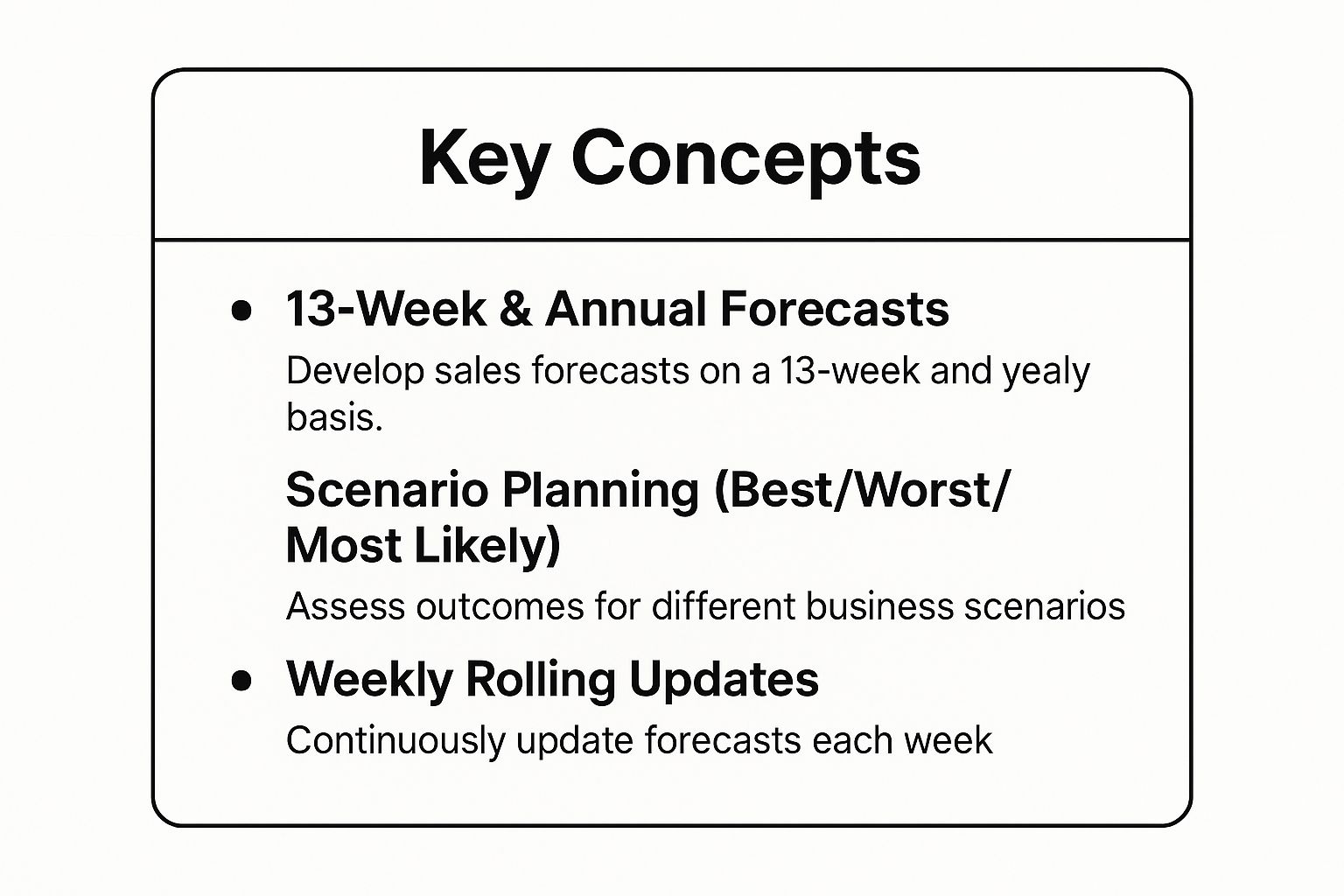Stay Updated with Everything about MDS
Thank you! Your submission has been received!
Oops! Something went wrong while submitting the form.

Chilat Doina
October 1, 2025
For high-growth e-commerce businesses and top-tier Amazon sellers, cash flow isn't just about paying the bills; it's the fuel for expansion, inventory investment, and market dominance. While generic advice floods the internet, scaling to seven, eight, or even nine figures requires a more sophisticated playbook. The challenge isn't just managing money; it's strategically deploying it to outpace competitors and seize opportunities without hitting a cash crunch.
Mastering a set of effective cash flow management strategies is often the single most critical factor separating stalled brands from market leaders. The constant need to reinvest in inventory, fund marketing campaigns, and navigate unpredictable supply chains puts immense pressure on liquidity. Founders in elite communities like Million Dollar Sellers understand this reality intimately: mastering cash flow is the difference between stalling out and building a legacy brand.
This article moves beyond surface-level tips to provide seven advanced, actionable strategies specifically designed for the unique demands of high-volume online retail. Each strategy is a lever you can pull to improve liquidity, fund growth, and build a more resilient e-commerce empire. From dynamic forecasting and inventory optimization to leveraging technology and strategic financing, you will learn the precise tactics required to maintain financial health during rapid scaling. To further enhance your understanding of achieving optimal financial health, explore these 4 proven strategies for positive cash flow.
We'll break down how to implement each of these concepts with practical examples tailored for the e-commerce landscape. Let's dive into the tactics the pros use to stay ahead.
Cash flow forecasting is the compass for your e-commerce business, providing a detailed roadmap of your future financial landscape. It’s a proactive strategy that involves projecting your cash inflows (from sales, financing, etc.) and outflows (inventory purchases, marketing spend, operating costs) over a specific period. This foresight allows you to anticipate potential shortfalls or surpluses, enabling strategic decisions instead of reactive fixes.
For a high-growth Amazon seller, a forecast can mean the difference between stocking up for Prime Day and missing out due to a cash crunch. It moves you from guessing to knowing, transforming financial management from an art into a science.
The core of this strategy is building a detailed financial model. This isn't a static, one-time document but a living forecast, typically a 13-week short-term view for tactical decisions and a 12-month rolling forecast for strategic planning. You'll use historical sales data, current market trends, planned marketing campaigns, and seasonal demand shifts to build your projections.
Key Insight: A common mistake is treating forecasting as a purely historical exercise. Effective cash flow management strategies integrate future plans, like a new product launch or a major ad campaign, to create a truly predictive model.
For example, a Shopify store owner planning a Black Friday sale would model the anticipated spike in revenue against the required upfront inventory investment and increased ad spend. This process reveals precisely when cash will be tight and how much working capital is needed to bridge the gap.
To help you visualize the core components of a robust forecasting system, here is a quick reference guide.

This structured approach, combining short-term agility with long-term vision and scenario analysis, provides the comprehensive view needed to navigate market volatility.
To make your forecasting effective, consider these practical steps:
Accounts receivable (A/R) optimization is a systematic approach to accelerating customer payments and shrinking the time it takes to get cash in the bank after a sale. For e-commerce businesses, especially those in the B2B space or offering wholesale terms, this means streamlining every step from invoicing to collections. This strategy directly impacts your cash conversion cycle, freeing up capital that would otherwise be tied up in unpaid invoices.
This isn't just about chasing late payments; it’s about architecting an efficient system that makes paying you fast and easy. For a brand selling to retail partners, optimizing A/R can prevent the cash flow gaps that stall inventory orders and marketing campaigns, turning a potential liability into a predictable source of liquidity.

The goal is to minimize your Days Sales Outstanding (DSO), the average number of days it takes to collect payment after a sale. This is achieved by implementing clear credit policies, automating billing processes, and establishing a consistent follow-up cadence. The strategy transforms collections from a manual, often-neglected task into an automated, efficient part of your financial operations.
Key Insight: Many e-commerce founders focus entirely on sales volume but neglect the speed of collection. Effective cash flow management strategies recognize that a sale isn't complete until the cash is in the bank. Reducing DSO is often a faster and cheaper way to unlock working capital than seeking external financing.
For instance, a wholesale apparel brand can implement a system where invoices are automatically generated and sent the moment an order ships. The system then sends polite, automated reminders before the due date, on the due date, and at set intervals afterward. This proactive approach prevents invoices from being forgotten and significantly shortens the payment cycle.
To make your A/R optimization effective, consider these practical steps:
For any e-commerce business, inventory is both your greatest asset and a potential cash flow trap. Effective inventory management is a delicate balancing act: holding too much ties up capital that could be used for growth, while holding too little risks stockouts and lost sales. This strategy focuses on minimizing the cash locked in unsold goods by adopting lean, just-in-time (JIT) principles.
This approach, pioneered by Toyota and now a cornerstone of efficient supply chains, aims to have just enough inventory to meet immediate demand. For an Amazon FBA seller, this means reducing long-term storage fees and improving their Inventory Performance Index (IPI) score, directly impacting profitability. It shifts inventory from a static cost center to a dynamic, cash-efficient asset.

The core principle is to align inventory purchasing directly with sales forecasts, reducing the time goods spend sitting in a warehouse. This requires a deep understanding of your sales cycles, supplier lead times, and demand variability. By optimizing this flow, you convert inventory back into cash much faster, dramatically improving your cash conversion cycle.
Key Insight: Many e-commerce brands over-order inventory based on "best-case scenario" sales projections, creating a cash flow burden. A true JIT approach relies on data-driven reorder points and strong supplier relationships to enable smaller, more frequent orders that mirror actual demand.
Consider Zara, which revolutionized fashion retail by keeping only six months of stock compared to the industry average of twelve. This allows them to respond to trends quickly and avoid the deep discounting that erodes margins and ties up cash. By synchronizing production with real-time sales data, they optimize one of the most critical cash flow management strategies in retail.
This data-centric system, supported by robust supplier communication and inventory software, provides the agility needed to manage working capital effectively in a fast-paced market.
To implement a lean inventory system, focus on these practical steps:
Strategic accounts payable (AP) management transforms a typically reactive function into a powerful tool for cash conservation. Instead of simply paying bills as they arrive, this approach involves the deliberate optimization of payment timing and supplier relationships to hold onto your cash longer. It’s a delicate balance between maximizing your working capital and maintaining strong partnerships with vendors who are crucial to your success.
For a growing e-commerce brand, strategically managing payables can free up vital cash to invest in inventory for a new product launch or a peak season marketing push. It shifts your AP process from a cost center to a strategic cash flow management lever.
The core of this strategy is to treat your payment terms as a negotiable asset. This means actively working with suppliers to secure longer payment windows (e.g., moving from Net 30 to Net 60 or Net 90) and analyzing when to take advantage of early payment discounts. It’s about scheduling outflows to align perfectly with your cash inflows, preventing unnecessary cash crunches.
Key Insight: A common misconception is that paying bills late is a viable cash management strategy. Strategic AP management is about paying on time, but at the latest possible time within your agreed-upon terms, preserving your credit and supplier trust.
For instance, a DTC furniture seller might negotiate Net 75 terms with its manufacturers. By selling products and receiving customer payments within 30-45 days, the business can use that cash for nearly a month to cover operational costs before the supplier payment is due. This creates a positive cash conversion cycle fueled by smart AP tactics.
To implement a strategic AP process, consider these practical steps:
Establishing a line of credit is like building a financial safety net for your e-commerce business. It provides a pre-approved, revolving source of capital that you can draw from as needed, offering immediate liquidity without the lengthy process of a traditional loan application each time. This strategy ensures you have cash on hand to navigate unexpected challenges or seize lucrative opportunities.
For an ambitious Amazon seller, a line of credit can be the key to capitalizing on a competitor's stockout or funding a large, opportunistic inventory purchase at a steep discount. It transforms potential cash flow gaps from business-threatening crises into manageable operational hurdles, providing the agility required in the fast-paced e-commerce market.
The core of this strategy is to secure a financing facility before you desperately need it. Unlike a term loan, which provides a lump sum upfront, a line of credit offers a maximum borrowing limit that you can tap into, repay, and reuse. You only pay interest on the amount you draw, making it a cost-effective tool for managing short-term cash flow fluctuations.
Key Insight: A common mistake is waiting until a cash crunch hits to seek financing. Lenders are far more willing to extend credit to a financially healthy business. Securing a line of credit during periods of strong performance is a crucial element of proactive cash flow management strategies.
For example, a direct-to-consumer brand might use its line of credit to bridge the 30- to 60-day gap between paying suppliers for a new product line and receiving revenue from initial sales. Once customer payments come in, they can pay down the balance, restoring their borrowing capacity for the next growth initiative.
To effectively integrate a line of credit into your financial toolkit, consider these practical steps:
In today's fast-paced e-commerce environment, manual cash management is a significant bottleneck. Technology-driven cash management is the strategic use of financial technology (fintech) and automated systems to gain real-time visibility into your cash position, streamline processes, and make data-backed decisions instantly. This approach moves beyond basic spreadsheets, employing cloud platforms, APIs, and AI to create an integrated and efficient financial ecosystem.
For an Amazon seller managing multiple international marketplaces, this means consolidating cash data from various sources into one dashboard instead of spending hours manually compiling reports. It transforms reactive, labor-intensive tasks into a proactive, automated system, freeing up capital and time to focus on growth.
The core of this strategy is to build an interconnected "tech stack" where your financial tools communicate with each other. This involves using cloud-based accounting software as a central hub, connected to your payment gateways (like Stripe or PayPal), expense management apps, and inventory systems. APIs (Application Programming Interfaces) act as the bridges that allow this seamless flow of data, eliminating manual entry and reducing human error.
Key Insight: The goal isn't just to adopt technology but to create a unified system. A standalone tool offers limited value; an integrated stack provides a comprehensive, real-time view of your entire financial health, which is one of the most powerful cash flow management strategies available.
For instance, when a sale is made on your Shopify store, an integrated system can automatically update your accounting records in Xero, adjust inventory levels in your management software, and project future cash inflows based on payment processing times. This real-time data flow allows for more accurate forecasting and quicker identification of potential cash gaps.
To effectively leverage technology for cash management, follow these practical steps:
Expense control is the defensive line of your cash flow management strategies, systematically protecting your capital by scrutinizing every dollar that leaves your business. This isn't about drastic, business-crippling cuts; it's a disciplined approach to identifying, monitoring, and reducing costs to maximize efficiency. By optimizing spending, you directly increase the cash available for growth-driving activities like inventory investment and marketing.
For an e-commerce brand scaling rapidly, even minor inefficiencies can compound into significant cash drains. A 5% reduction in shipping costs or a 10% saving on SaaS subscriptions doesn't just save money, it frees up capital that can be immediately reinvested, accelerating your growth flywheel.
This strategy involves embedding cost optimization into your operational DNA. It starts with a comprehensive review of all business expenses, from major costs like Cost of Goods Sold (COGS) and advertising to smaller, recurring software fees. The goal is to categorize, question, and justify every expenditure, ensuring it directly contributes to revenue or operational stability.
Key Insight: Effective cost optimization isn't a one-time audit but a continuous process. The most successful e-commerce businesses build systems that constantly review spending, benchmark costs against industry standards, and empower teams to find savings.
For example, an Amazon seller might analyze their fulfillment fees and discover that slight changes in product packaging dimensions could move an item into a lower FBA fee tier, saving thousands annually. Similarly, a DTC brand might consolidate its marketing tech stack, eliminating redundant tools and negotiating a volume discount with a single provider.
This systematic approach transforms expense management from a reactive chore into a proactive, strategic advantage that preserves precious cash flow.
To make expense control a powerful part of your financial toolkit, consider these steps:
Navigating the volatile currents of e-commerce requires more than just a great product and clever marketing; it demands a deep, functional mastery of your business’s financial lifeblood: its cash flow. Throughout this guide, we have explored seven powerful and actionable cash flow management strategies, moving far beyond generic advice to provide a tactical playbook for high-growth Amazon sellers and e-commerce brand owners. From the predictive power of a 13-week cash flow forecast to the strategic leverage of accounts payable, each strategy represents a critical lever you can pull to enhance stability, unlock growth, and build a more resilient operation.
You’ve learned how to turn your accounts receivable into a rapid source of cash, how to optimize inventory to eliminate capital dead zones, and how to utilize flexible financing as a strategic tool rather than a last resort. We also highlighted the non-negotiable role of technology in automating financial oversight and the immense value found in meticulous expense control. These aren’t isolated tactics to be deployed in a crisis; they are interconnected components of a holistic financial engine.
The true power of these cash flow management strategies is not found in isolation but in their integration. Think of it as building a financial flywheel for your business.
This interconnected system creates a virtuous cycle. Better data leads to better decisions, which frees up more cash, which in turn fuels more growth and provides more data. Your management of cash flow transforms from a reactive, defensive posture into a proactive, offensive weapon that allows you to seize opportunities-like bulk inventory buys or competitor acquisitions-that others cannot.
Mastering cash flow is a continuous discipline, not a one-time project. To move from reading to doing, take these immediate next steps:
Ultimately, robust cash flow management is what separates fleeting e-commerce successes from enduring brands. It provides the stability to weather market downturns, the agility to pivot when needed, and the fuel to scale aggressively. By implementing these strategies, you are not just managing money; you are building a fortress around your business and paving a clear runway for future growth.
Ready to accelerate your learning and execute these strategies with insights from the world's top Amazon sellers? Join Million Dollar Sellers, an exclusive community where elite e-commerce entrepreneurs share the exact financial tactics, software stacks, and operational secrets they use to scale their brands. Learn more and see if you qualify at Million Dollar Sellers.
Join the Ecom Entrepreneur Community for Vetted 7-9 Figure Ecommerce Founders
Learn MoreYou may also like:
Learn more about our special events!
Check Events